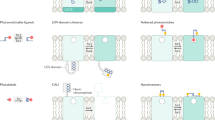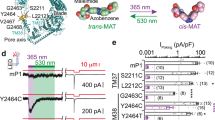Abstract
The precise regulation of protein activity is fundamental to life. The allosteric control of an active site by a remote regulatory binding site is a mechanism of regulation found across protein classes, from enzymes to motors to signaling proteins. We describe a general approach for manipulating allosteric control using synthetic optical switches. Our strategy is exemplified by a ligand-gated ion channel of central importance in neuroscience, the ionotropic glutamate receptor (iGluR). Using structure-based design, we have modified its ubiquitous clamshell-type ligand-binding domain to develop a light-activated channel, which we call LiGluR. An agonist is covalently tethered to the protein through an azobenzene moiety, which functions as the optical switch. The agonist is reversibly presented to the binding site upon photoisomerization, initiating clamshell domain closure and concomitant channel gating. Photoswitching occurs on a millisecond timescale, with channel conductances that reflect the photostationary state of the azobenzene at a given wavelength. Our device has potential uses not only in biology but also in bioelectronics and nanotechnology.

This is a preview of subscription content, access via your institution
Access options
Subscribe to this journal
Receive 12 print issues and online access
$259.00 per year
only $21.58 per issue
Buy this article
- Purchase on Springer Link
- Instant access to full article PDF
Prices may be subject to local taxes which are calculated during checkout




Similar content being viewed by others
References
Feringa, B.L. Ed. Molecular Switches. (Wiley-VCH, Weinheim, Germany, 2001).
Goeldner, M. & Givens, R. Dynamic Studies in Biology. (Wiley-VCH, Weinheim, Germany, 2005).
Lester, H.A., Krouse, M.E., Nass, M.M., Wassermann, N.H. & Erlanger, B.F. Covalently bound photoisomerizable agonist - Comparison with reversibly bound agonists at electrophorus electroplaques. J. Gen. Physiol. 75, 207–232 (1980).
Kocer, A., Walko, M., Meijberg, W. & Feringa, B.L. A light-actuated nanovalve derived from a channel protein. Science 309, 755–758 (2005).
Banghart, M., Borges, K., Isacoff, E., Trauner, D. & Kramer, R.H. Light-activated ion channels for remote control of neuronal firing. Nat. Neurosci. 7, 1381–1386 (2004).
Paas, Y. The macro- and microarchitectures of the ligand-binding domain of glutamate receptors. Trends Neurosci. 21, 117–125 (1998).
Dingledine, R., Borges, K., Bowie, D. & Traynelis, S.F. The glutamate receptor ion channels. Pharmacol. Rev. 51, 7–61 (1999).
Pin, J.P., Galvez, T. & Prezeau, L. Evolution, structure, and activation mechanism of family 3/C G-protein-coupled receptors. Pharmacol. Ther. 98, 325–354 (2003).
Kandel, E.R., Schwartz, J.H. & Jessell, T.M. Eds. Principles of Neural Science Ed. 4. (McGraw-Hill, New York, 2000).
Erreger, K., Chen, P.E., Wyllie, D.J. & Traynelis, S.F. Glutamate receptor gating. Crit. Rev. Neurobiol. 16, 187 (2004).
Armstrong, N. & Gouaux, E. Mechanisms for activation and antagonism of an AMPA-Sensitive glutamate receptor: Crystal structures of the GluR2 ligand binding core. Neuron 28, 165–181 (2000).
Mayer, M.L. Crystal structures of the GluR5 and GluR6 ligand binding cores: Molecular mechanisms underlying kainate receptor selectivity. Neuron 45, 539–552 (2005).
Nanao, M.H., Green, T., Stern-Bach, Y., Heinemann, S.F. & Choe, S. Structure of the kainate receptor subunit GluR6 agonist-binding domain complexed with domoic acid. Proc. Natl. Acad. Sci. USA 102, 1708–1713 (2005).
Johansen, T.N., Greenwood, J.R., Frydenvang, K., Madsen, U. & Krogsgaard-Larsen, P. Stereostructure-activity studies on agonists, at the AMPA and kainate subtypes of ionotropic glutamate receptors. Chirality 15, 167–179 (2003).
Pedregal, C. et al. 4-alkyl- and 4-cinnamylglutamic acid analogues are potent GluR5 kainate receptor agonists. J. Med. Chem. 43, 1958–1968 (2000).
Kohler, M., Burnashev, N., Sakmann, B. & Seeburg, P.H. Determinants of Ca2+ permeability in both TM1 and TM2 of high-affinity kainate receptor channels - diversity by RNA editing. Neuron 10, 491–500 (1993).
Grynkiewicz, G., Poenie, M. & Tsien, R.Y. A new generation of Ca-2+ indicators with greatly improved fluorescence properties. J. Biol. Chem. 260, 3440–3450 (1985).
Knoll, H. in CRC Handbook of Organic Photochemistry and Photobiology (eds. Horspool, W., & Lenci, F.) Vol. 89, 1–89 (CRC, Boca Raton, Florida, 2004).
Jin, R.S., Banke, T.G., Mayer, M.L., Traynelis, S.F. & Gouaux, E. Structural basis for partial agonist action at ionotropic glutamate receptors. Nat. Neurosci. 6, 803–810 (2003).
Kercher, M.A., Lu, P. & Lewis, M. Lac repressor operator complex. Curr. Opin. Struct. Biol. 7, 76–85 (1997).
Kunishima, N. et al. Structural basis of glutamate recognition by a dimeric metabotropic glutamate receptor. Nature 407, 971–977 (2000).
Furukawa, H. & Gouaux, E. Mechanisms of activation, inhibition and specificity: crystal structures of the NMDA receptor NR1 ligand-binding core. EMBO J. 22, 2873–2885 (2003).
Chen, X. et al. Structural identification of a bacterial quorum-sensing signal containing boron. Nature 415, 545–549 (2002).
Bayley, H. & Jayasinghe, L. Functional engineered channels and pores. Mol. Membr. Biol. 21, 209–220 (2004).
Dwyer, M.A. & Hellinga, H.W. Periplasmic binding proteins: a versatile superfamily for protein engineering. Curr. Opin. Struct. Biol. 14, 495–504 (2004).
Willner, I. & Willner, B. Molecular and biomolecular optoelectronics. Pure Appl. Chem. 73, 535–542 (2001).
Balzani, A.C.V. & Venturi, M. Molecular Devices and Machines: A Journey Into the Nanoworld (Wiley-VCH, Weinheim, Germany, 2003).
Wilding, T.J. & Huettner, J.E. Activation and desensitization of hippocampal kainate receptors. J. Neurosci. 17, 2713–2721 (1997).
Partin, K.M., Patneau, D.K., Winters, C.A., Mayer, M.L. & Buonanno, A. Selective modulation of desensitization at AMPA versus kainate receptors by cyclothiazide and concanavalin-A. Neuron 11, 1069–1082 (1993).
Ezquerra, J. et al. Stereoselective reactions of lithium enolates derived from N-Boc protected pyroglutamic esters. Tetrahedron 49, 8665–8678 (1993).
Acknowledgements
We thank K. Partin for the iGluR6 cDNA and for advice, T. Machen for guidance on calcium imaging and S. Szobota for participation in initial imaging experiments. P.G. was supported by postdoctoral fellowships from the Generalitat de Catalunya (Nanotechnology Program), Ministerio de Educación y Ciencia (Spain) and the Human Frontier Science Program. R.N. was supported by a postdoctoral fellowship from the Japan Society for the Promotion of Science. This work was supported by a Laboratory Directed Research Development Award from the Lawrence Berkeley National Laboratory and by a grant from the Human Frontier Science Program. D.T. thanks Eli Lilly, Astra Zeneca, Glaxo Smith Kline, Amgen and Merck & Co. for Young Investigator Awards.
Author information
Authors and Affiliations
Corresponding authors
Ethics declarations
Competing interests
The authors declare no competing financial interests.
Supplementary information
Rights and permissions
About this article
Cite this article
Volgraf, M., Gorostiza, P., Numano, R. et al. Allosteric control of an ionotropic glutamate receptor with an optical switch. Nat Chem Biol 2, 47–52 (2006). https://doi.org/10.1038/nchembio756
Received:
Accepted:
Published:
Issue Date:
DOI: https://doi.org/10.1038/nchembio756
This article is cited by
-
Astrocytes: new evidence, new models, new roles
Biophysical Reviews (2023)
-
Cardiac optogenetics: shining light on signaling pathways
Pflügers Archiv - European Journal of Physiology (2023)
-
Coordination chemogenetics for activation of GPCR-type glutamate receptors in brain tissue
Nature Communications (2022)
-
Orthogonal Control of Neuronal Circuits and Behavior Using Photopharmacology
Journal of Molecular Neuroscience (2022)
-
Image-guided neural activity manipulation with a paramagnetic drug
Nature Communications (2020)



